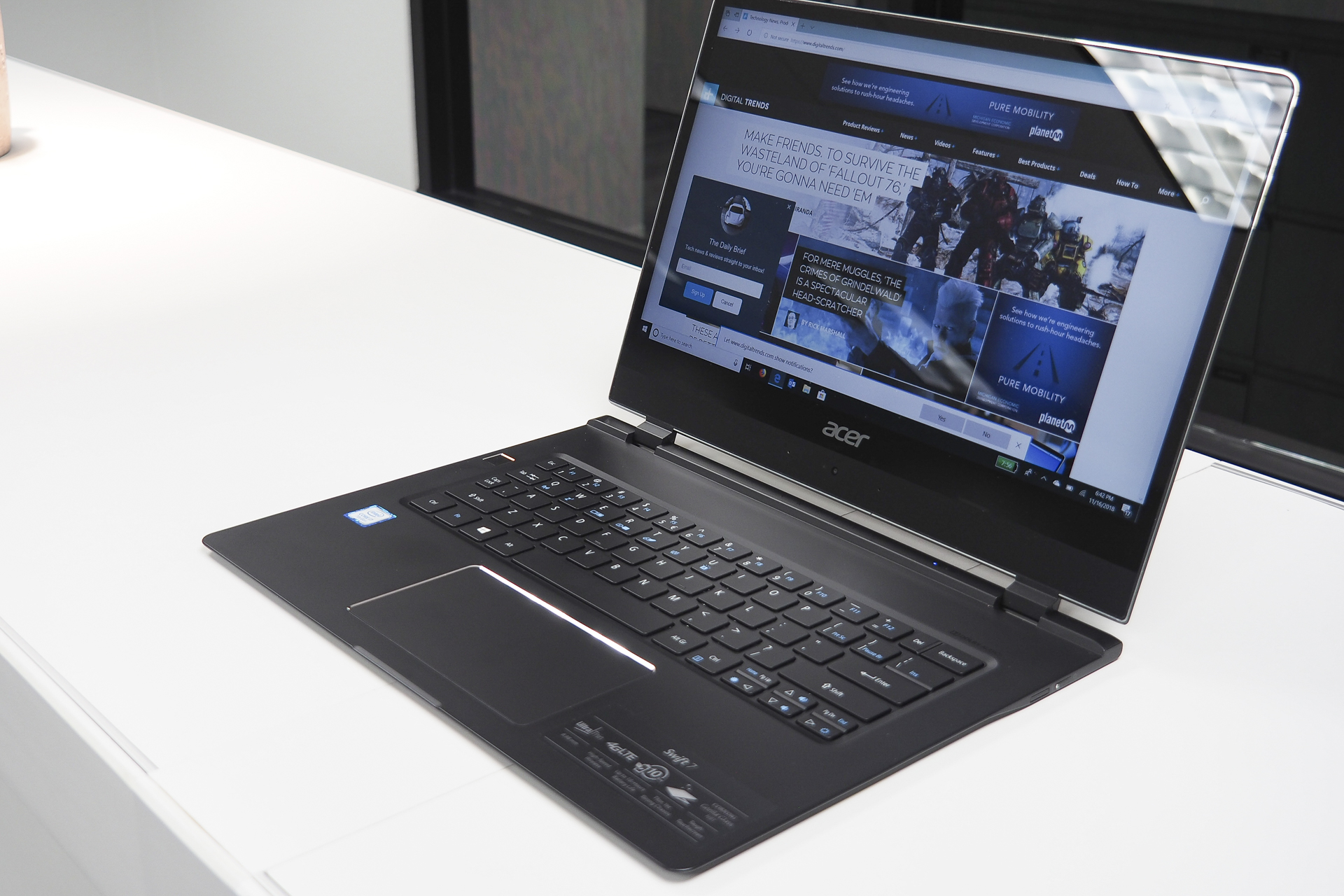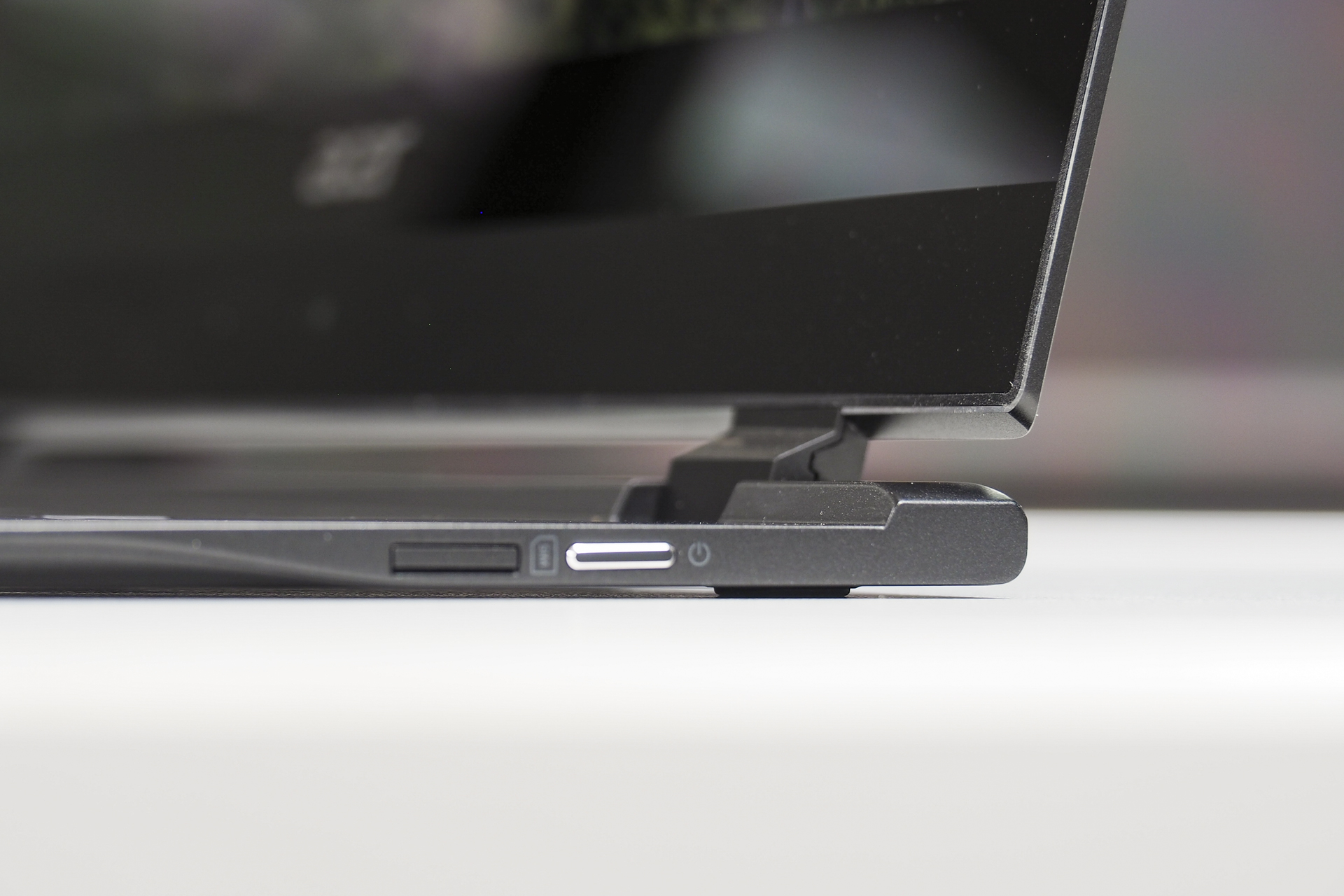
Now and then, a notebook is released that’s aimed at accomplishing a singular purpose. For Acer’s Swift 7, that’s to be the world’s thinnest notebook, and it’s certainly very thin. Whether that’s a good thing depends entirely on what you’re looking for in a notebook.
Of course, the Swift 7 also doesn’t exist in a vacuum. It’s pitted against a host of alternatives running a number of operating systems, and the recent MacBook Air was just reintroduced for MacOS fans. We take a look here at whether the Swift 7’s thinness is enough to give it a head-to-head win.
Design

Holding the Swift 7 in hand is a bit like reaching into the future — the notebook seems impossibly thin to actually contain the guts of a real computer. At 0.35 inches, Acer’s sliver of a notebook rivals the iPhone X in thickness. Apple’s newest option, the MacBook Air, seems downright chunky by comparison, at up 60 0.61 inches at the rear.
And yet, they both weigh roughly the same, at 2.6 pounds for the Swift 7 and 2.75 pounds for the MacBook Air. That’s because they’re both very solidly constructed of aluminum, and the Swift 7 packs in a 14-inch display compared to the MacBook Air’s 13.3-inch panel. They both resist flexing and bending, and they both exude a distinct impression of quality. They’re both also limited to just USB-C ports, although Apple’s version includes Thunderbolt 3 support.
Another area where they differ is in their aesthetic. Acer went with an obsidian black color scheme that helps the Swift 7 disappear when held on edge, with chamfer diamond-cut edges adding the only real visual flair. The MacBook Air, on the other hand, offers three colors — Gold, Silver, and Space Gray — and a look and feel that retains the older version’s wedge shape but is entirely in line with the MacBook line’s generally elegant and simplistic design.
Finally, consider their input options. The Swift 7, despite being incredibly thin, manages to incorporate a traditional island keyboard with plenty of travel and a snappy feel but a non-standard layout that’s hard to get learn. That compares to the MacBook Air’s 3rd-gen butterfly keyboard with extremely short travel that people tend to love or hate. Acer’s biggest gamble with the Swift 7 is its choice of a touchpad that’s a solid piece without clickable buttons — and we didn’t like it very much. The MacBook Air’s touchpad also eschews physical buttons, but its Force Touch haptic feedback engine makes it feel like a more traditional option.
The Swift 7 accomplishes its design goal of being incredibly thin, and it’s just as well-built as the MacBook Air. But Acer’s decision to omit any kind of touchpad click — real or imitated — gives the MacBook Air a win here.
Performance

Both the Swift 7 and the MacBook Air rely on Intel’s Y-series CPUs, dual-core processors that aim at providing good enough performance for productivity tasks while sipping power, reducing heat and saving battery life. Only Acer was limited to the 7th-generation Core i7-7Y75 when it introduced the Swift 7, while Apple went with a special 8th-generation version, the Core i5-8210Y on our review unit that can ramp up beyond the usual Y-series limit of five watts to seven watts.
The result is that the Swift 7 falls noticeably behind the MacBook Air in performance. Toss in a much faster PCI solid-state drive (SSD) in the MacBook Air, and Acer’s razor-thin notebook can’t quite keep up.
The Swift 7 utilizes a Full HD (1,920 x 1,080) 14-inch display that isn’t nearly as sharp as the 2,560 x 1,600 13.3-inch panel on MacBook Air. However, Apple stepped back in display quality on this version, and while the MacBook Air’s display offers a wider color gamut with better accuracy, the Swift 7 offers significantly better contrast and brightness. It’s close to a wash.
Neither of these notebooks is a speed demon, but the MacBook Air is going to keep up better with your slightly more demanding productivity tasks.
Portability

The Swift 7 will slide into a thinner crevice in your backpack, but it’s going to take up just as much room and weigh almost as much as the MacBook Air. But that’s not saying much — you’ll barely notice either of these notebooks as you move from place to place.
When it comes to the other important measure of portability — how long they can last on a single charge of the battery — the MacBook Air pulls ahead. The Swift 7 ran our demanding Basemark benchmark for 15 minutes longer than the MacBook Air, but lost out on web browsing by almost two hours and on playing video by about half an hour.
Neither of these thin and light notebooks will weigh you down, and neither wins any records for battery life either. But the MacBook Air is more likely to get you through a full working day without plugging in, so it wins this round.
The MacBook Air compromises less for its achievements

You pay a premium to pack so much computing power into so thin a chassis, with the Swift 7 coming in at $1,700 for the Core i7, 8GB of RAM, and a 256GB SSD. That’s very expensive for the configuration.
The MacBook Air is a bit more economical, starting at $999 with a Core i5, 8GB of RAM, and a 128GB SSD. The price goes up to $1,399 for a Core i5, 8GB of
The Swift 7 succeeds in its sole purpose of being the world’s thinnest notebook. But the MacBook Air is the better notebook by just about every other measure.
Editors' Recommendations
- The XPS 16 is fighting an uphill battle against the MacBook Pro
- MacBook Pro 16 vs. MacBook Pro 14: The important differences
- Best refurbished MacBook deals: Get a MacBook Air for $140 and more
- Best MacBook deals: Get an Air for $605 and save on M3 MacBook Pro
- Best Apple deals: Save on AirPods, Apple Watch, iPad, MacBook


